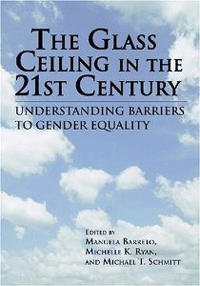The Glass Ceiling in the 21st Century: Understanding Barriers to Gender Inequality

“The Glass Ceiling in the 21st Century: Understanding Barriers to Gender Inequality”
Edited by Manuela Barreto, Michelle K. Ryan & Michael T. Schmitt
American Psychological Association
Washington, D.C., 2009
Compelling volume looks at discrimination in the workplace
Reviewed By Paul Efthim, Ph.D.
Recent references to the “glass ceiling” in public discourse suggest that women finally are breaking through this longstanding barrier.
On the cover of the January 2 issue of the Economist, a wartime Rosie the Riveter flexes her bicep, declaring “We Did It!” An accompanying editorial notes that women now make up the majority of the American workforce, gushing that women are “taking a sledgehammer to the remaining glass ceilings.”
Similar references have come from the political sphere. Nancy Pelosi, upon becoming Speaker of the House in 2007, said she had broken “the marble ceiling.” In Hillary Clinton’s 2008 concession speech, she remarked that her 18 million votes in the primaries led to “18 million cracks” in the “highest, hardest glass ceiling.”
Really? Although women have certainly made major strides over the past generation, they continue to be sorely underrepresented at the top of the political and economic ladder. In Pelosi’s House of Representatives, women make up only 16 percent of members. Among Fortune 500 companies, women account for only 2 percent of CEOs and less than 15 percent of board members.
With news reports about shattered ceilings sitting next to such low statistics, no wonder we find ourselves confused about the extent of gender inequality. Helping make sense of the picture is a fine new book by leading social and organizational psychologists from North America and the European Union.
“The Glass Ceiling in the 21st Century” is a sophisticated volume that analyzes the psychological phenomena that block women’s access to the highest positions of power in society. Drawing on important theory and research from the past decade, this edited collection focuses on subtle barriers to women seeking leadership positions in the workplace.
A common thread running through the book’s 12 chapters is how gender discrimination has become more complex and subtle over time. Modern sexism, like other forms of discrimination, is harder to notice than old-fashioned sexism. As a result, individuals find it harder to identify when discrimination is taking place, and their emotional experiences are less available to awareness. For example, blatant sexism tends to lead to anger in the target, who then is more likely to protest. On the other hand, subtle sexism tends to generate anxiety and low self-esteem, which are emotional responses less likely to lead to protest.
One of the most insidious and powerful forces facing female leaders is the mismatch between stereotypes about leaders and women. People expect women to be relational but they expect leaders to be agentic. Thus, women leaders frequently find themselves in a bind: they get stereotyped as competent or warm, but not both. Research shows how men in leadership roles enjoy much more latitude to be both warm and competent. Even in female-majority workplaces, bias against women leaders is well-documented.
The contributors also document several other relevant phenomena. The “glass escalator” refers to how men move up the career ladder faster than women, even in female-dominated fields. Women who do break through the glass ceiling often face a “glass cliff” because they are more likely to be appointed to lower-quality leadership positions associated with a higher risk of failure. And gender stereotyping (for example, boys are better than girls at math) functions as a “glass door” by closing off entry to certain career fields.
Several chapters take up a range of solutions, including assessment of work-life policies, affirmative action and diversity management.
Anyone who is interested in gender equality in the workplace will want to read this compelling, well-written volume.
Paul Efthim, Ph.D. is a licensed psychologist in private practice in Brookline, Mass. and holds a faculty appointment at the Boston Institute for Psychotherapy.
Learn more about the book: The Glass Ceiling in the 21st Century: Understand Barriers to Gender Equality (Psychology of Women Books)
